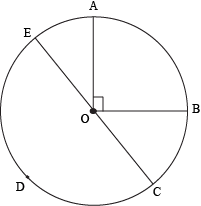The measure of a central angle tells us something about its intercepted arc: how "much of a circle" that arc is. The measure (sometimes called the degree measure) of an arc is equal to the measure of the central angle that intercepts that arc.

In the figure above, both ∠AOB and arc AB have measures of 90°. Both ∠COE and arc CDE have measures of 180°.
Every arc falls into exactly one of the following categories, depending on its measure.
1. An arc with measure less than 180° is a minor arc.
2. An arc with measure greater than 180° is a major arc.
3. An arc with measure equal to 180° is a semicircle.
Note that a major arc's buddy is always a minor arc, and vice versa. A semicircle's buddy is always a semicircle. They're basically twins, like Lindsay Lohan and…uh…Lindsay Lohan.
Sample Problem
An arc has a measure of 73°. Is its buddy a minor arc, a major arc, or a semicircle arc? What is its measure?
Since 73° is less than 180°, we know that the first arc is a minor one. Since the buddy of a minor arc is always a major arc, we know right off the bat that our arc is major. We can find its measure by subtracting our original arc from the total measure of the circle. That gives us 360° – 73° = 287°. Our arc has a measure of 287°, much larger than 180° and definitely major.
In addition to its measure, arcs have another property called arc length. The length of an arc is the distance a bug would have to crawl from one endpoint of the arc to the other, while staying on the circle the whole time.
It's important to remember that arc length and arc measure are NOT the same.
If you're ever unsure whether you're dealing with arc length or arc measure, check the units. Arc measure is almost always given in units of degrees. Arc length, on the other hand, is a length, and so it may be given in units of meters, feet, inches, kilometers, or unhelpfully, "units," but certainly not degrees. (Don't be afraid of units. They're there to help you.)
It's pretty important to be able to tell when two things are different and when they're the same. It's a good skill to have, regardless of how you feel about circles, geometry, or Sesame Street.